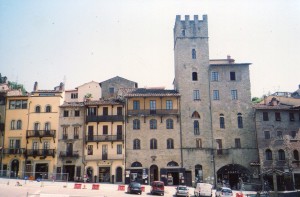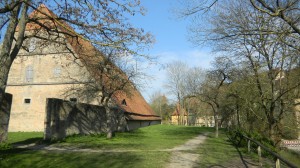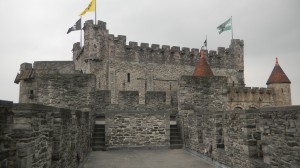Gothic style was more than art and architecture. The posts in The Many Worlds of Gothic Style series explore the meanings of Gothic architecture. But many other things happened outside the cathedrals and palaces to make Gothic art meaningful and possible.
Towns began to grow in Europe in the late 10th century after barbarian invasions (Viking, Saracen and Magyar) subsided. The cultural landscape that grew became a seedbed for the great Gothic cathedrals, and it was one of the world history’s most fascinating.Several things encouraged Europe’s renaissance:
1. People cleared forests and drained marshes, and thus put more land under cultivation.
2. People improved farming technologies. They made heavier plows that could dig deeply into hard northern European soils.
3. Farmers began to use the harness, which allowed horses to pull plows by putting the stress on their shoulders, rather than on their windpipes–this multiplied their pulling power 4 or 5 times.
4. Folks developed a three-fold system of crop rotation that produced more from the land by using two fields each year and allowing the other to lie fallow and replenish itself. They also used more manure to fertilize soils.
5. As people settled into more villages and towns, new parishes emerged. Europe became a settled checkerboard of districts headed by a bishop, and each parish was centered on the cathedral. These palaces of worship were more worldly than the monasteries that had dominated Europe–they were in the centers of towns, rather than in the country.
6. And as communities became more settled, dukedoms had firmer boundaries. It now became standard for one son to inherit all of dad’s property. Europe was thus also becoming a checkerboard of lands that nobles, presiding in castles, held sway over.
Europe was thus transforming from a place with lots of unfarmed lands with vague standards of ownership, whose kings and dukes circulated between many homes as they renewed bonds with their subjects. By the 12th century, Europe was a tapestry of places with one duke and one bishop in charge, and ruling from a main palace or cathedral.
But this seemingly stable system was a seedbed for disorder:
1. There were lots of restless and ticked off young men who didn’t inherit anything. If your older brother gets all of your family’s wealth and bosses you around just because he came out of the womb first, you either find religion and enter a monastery, fight him to the death, or move and find your place in the world somewhere else.
2. Peasants were being abused by the fortunate sons who wanted to tax them through the noses.
3. The greater economic stability fostered the growth of towns, where peasants and younger sons could escape to.
These three things made Europe more dynamic and volatile than its lords wanted. They also made it more creative than they imagined–as we’ll see in the next post.




Comments on this entry are closed.